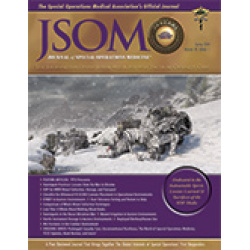Prescreened Whole O Blood Group Walking Blood Bank Capabilities for Nontraditional Maritime Medical Receiving Platforms: A Case Series
Chang R, Boyle BP, Udoh MO, Maestas JM, Gehrz JA, Ruano E, Banker L, Cap AP, Bitterman JW, Deaton TG, Auten JD 24(1). 60 (Journal Article)
Background: Tactical Combat Casualty Care (TCCC) guidelines recognize low-titer group O whole blood (LTOWB) as the resuscitative fluid of choice for combat wounded. Utilization of prescreened LTOWB in a walking blood bank (WBB) format has been well described by the Ranger O low-titer blood (ROLO) and the United States Marine Corps Valkyrie programs, but it has not been applied to the maritime setting. Methods: We describe three WBB experiences of an expeditionary resuscitative surgical system (ERSS) team, attached to three nontraditional maritime medical receiving platforms, over 6 months. Results: Significant variations were identified in the number of screened eligible donors, the number of LTOWB donors, and the timely arrival at WBB activation sites between the platforms. Overall, 95% and 84% of the screened eligible group O blood donors on the Arleigh Burke Class Destroyer (DDG) and Nimitz Class Aircraft Carrier (CVN), respectively, were determined to be LTOWB. However, only 37% of the eligible screened group O blood donors aboard the Harper's Ferry Class Dock Landing Ship (LSD) were found to be LTOWB. Of the eligible donors, 66% did not complete screening, with 52% citing a correctable reason for nonparticipation. Conclusion: LTOWB attained through WBBs may be the only practical resuscitative fluid on maritime platforms without inherent blood product storage capabilities to perform remote damage control resuscitation. Future efforts should focus on optimizing WBBs through capability development, education, and training efforts.


 Español
Español 



